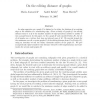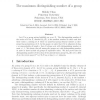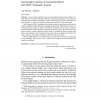JGT
2010
13 years 3 months ago
2010
An edge-colored graph G is rainbow edge-connected if any two vertices are connected by a path whose edges have distinct colors. The rainbow connection of a connected graph G, deno...
CORR
2002
Springer
13 years 4 months ago
2002
Springer
We introduce a new measure for planar point sets S that captures a combinatorial distance that S is from being a convex set: The reflexivity (S) of S is given by the smallest numb...
CPC
2004
13 years 4 months ago
2004
The strong chromatic number, S(G), of an n-vertex graph G is the smallest number k such that after adding kn/k-n isolated vertices to G and considering any partition of the vertic...
APPML
2005
13 years 4 months ago
2005
In the previous studies on k-edge fault tolerance with respect to hypercubes Qn, matrices for generating linear k-EFT(Qn) graphs were used. Let EFTL(n, k) denote the set of matric...
DAM
2007
13 years 4 months ago
2007
It is now well-documented that the structure of evolutionary relationships between a set of present-day species is not necessarily tree-like. The reason for this is that reticulat...
CORR
2007
Springer
13 years 4 months ago
2007
Springer
—For a linear block code C, its stopping redundancy is defined as the smallest number of check nodes in a Tanner graph for C, such that there exist no stopping sets of size smal...
JGT
2008
13 years 4 months ago
2008
An edge-operation on a graph G is defined to be either the deletion of an existing edge or the addition of a nonexisting edge. Given a family of graphs G, the editing distance fro...
COMBINATORICS
2006
13 years 4 months ago
2006
Let G be a group acting faithfully on a set X. The distinguishing number of the action of G on X, denoted DG(X), is the smallest number of colors such that there exists a coloring...
AIR
2006
13 years 4 months ago
2006
Abstract. An over-zealous machine learner can automatically generate large, intricate, theories which can be hard to understand. However, such intricate learning is not necessary i...
DM
2008
13 years 4 months ago
2008
The reinforcement number of a graph is the smallest number of edges that have to be added to a graph to reduce the domination number. We introduce the k-reinforcement number of a ...



